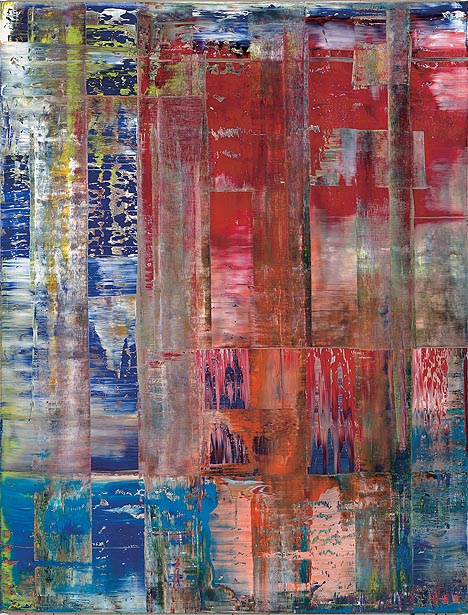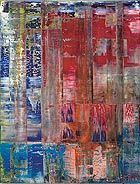
translated and summarized by: Liz Wollner-Grandville,
English summary April 1 - 6
Galerie Bleich-Rossi: Aribert von Ostrowski – The Diamond is not a Maximum
Naturalism
“An animal can easily be comprehended if you look at its outer shell”. This sentence pertaining to the field of natural sciences was coined by the French biologist George Cuvier; but like many other things, such as idiosyncrasy, hybrid, degeneration, it found its way into the field of aesthetics. Hippolyte Taine has taken this sentence and made it to a catchy formula for his Milieu Theory. As a naturalistic credo it would then mean: one can easily comprehend an artist, if you know where he lives.
Aribert von Ostrowski lives in Berlin. As one says today - he works and lives where millions of other artists work and live. And in the midst of merciless competition and willy-nilly buddying the artistic outcome is somewhat metropolitan. The collages, mixed media, illustrations, and paintings currently displayed at Gabriella Bleich-Rossi’s make this obvious. They have something coarse and mangy, a premonition of a survival struggle. They are paintings created in a major city, graffiti leaving its mark, some backgrounds made of newspapers, and when things get too abrasive, sentimentality presides through the usage of the format filling words “House in the heath”.
Twenty years ago Aribert Ostrowski lived in Munich. And it seems as if nothing has changed regarding his characteristic style. During the 80’s Ostrowski, born 1953, was a cool conceptualist, a gauger of the meta-levels, a picture scientist avant la lettre, whose reflective constructions were partly met with incomprehension in Munich, where everybody at that time was infatuated by adornments. But somehow his works managed to fit into the city’s “this is none of my business” atmosphere and its distinctive aesthetic attitude of “Mir san Mir” (we are who we are).
But there is none of all that now. Really none of it? Helmut Draxler wrote the accompanying text for Ostrowski’s exhibit. The same Draxler who quasi usurped the Münchner Kunstverein in 1992 and decreed that it should adhere to social reality. But this reality remained oblique, not written all over, captured analytically by people such as Terry Eagleton or Ernesto Laclau. Back then Ostrowski went along with the balancing act and accordingly the harshness of his current work is theoretically appeased. In the Viennese case: through Sigmund Freud. One can easily recognize an artist if you look at his outer shell. This shell is the art industry.
Galerie Bleich-Rossi
1010 Vienna– Dominikanerbastei 19, until 17.05.08
www.bleich-rossi.at
Museum Moderner Kunst Kärnten: abstrakt – abstract
Respectable
The current exhibit at the Museum Moderner Kunst Kärnten (MMKK) focuses on the genre of abstract art. The Director of the MMKK, Andrea Madeste, curated this show “as a conscious counteraction towards the general focus on ‘new figurative’ painting”. The large exhibit generates a harmonious historical access to the artistic abstraction of the 21st century.
But it is more than a didactic educational trail. 25 internationally renowned artists, who have created diverse concepts of abstract art, are presented at this exhibit, whose clever approach conjoins these different positions into a combined, balanced, abstract display. Thereby centre lines of paintings were created, allowing them to communicate with one another. However, none of the artistic positions lose their individual eidetic vigour. In many of the abstract works the seeming abandonment of figurative narration seems to release just this.
25 diverging artistic approaches, nearly just as many art techniques – including plexiglass imaging, assemblages, classic oil paintings, video installations, traditional sculptures, spatially encompassing installations – allow the onlooker to anticipate the theme’s vast extent. The remarkable monumental mirror wall created by the Swiss John M. Armleder transforms the onlooker’s actual “being” to a picture abstraction. Gerhard Richter’s colour intensive oil paintings or Gerald Rockenschaub’s artistic reductions are irresistible.
You will find Damien Hirst’s “Portfolio Box” next to the pasty “Schwarzfläche” by Anselm Reyle or Peter Zimmermann’s colours locked into epoxy resin. Tony Cragg’s fibreglass work “Stealth 2005” is somewhat of a prancing abstraction of ease. The French painter’s Bernard Frize broad strokes of brush present abstract colour intensities. The internationality of the artwork makes this exhibit a respectable one, respectable even beyond Carinthia’s borders.
Museum Moderner Kunst Kärnten
9020 Klagenfurt, Burggasse 8/Domgasse, until 20.04.08
www.mmkk.at
Martin-Gropius-Bau Berlin: Karl Valentin – Pioneer of Film and Artisan of Media
Avant-gardist of one’s half accord
Karl Valentin was an incomparably talented comedian. He could have easily competed with film gods such as Charlie Chaplin and Buster Keaton. His international film career failed mainly on account of the (visionary and financial) insufficiencies of the national film industry and later on account of the sufficiency of the Nazi film industry, which tolerated absolutely no humour regarding social criticism and solely propagated the farce of an ideal world, which in the meantime had been completely destroyed. All of these facts were common knowledge for a long time, at least since Valentin’s rediscovery in 1982, the year commemorating his 100th birthday. Besides the usual devotional objects such as props, movie posters, program flyers, and stills the two movie theatres at the exhibit in the Martin-Gropius-Bau also offer a humoristic insight into his work.
The exhibit focuses on the fact that Valentin was not only an object of film history, but also a subject of media history – a pioneer, who acknowledged the inescapable triumph of technical media with feelings of opposition as well as fascination. He worked hard on his artistic survival by utilizing experimental media. All of this is presented at this exhibit. Be it the photo collection of folk musicians from Munich, which at the same time is a kind of Mnemosyne-Atlas of grotesque formulas offering him a source for his own performances or his facetious idea to use a slide projector to show unusual advertisements (“clever housewives use Persil to cook”) during the intermissions of his own performances, proves how cleverly he used his cryptic humour to draw attention to himself. This can also be observed in the multimedia arrangements (“Der Flug zum Mond mit dem Raketenflugzeug”, “In der Schreinerwerkstatt”, both 1928), in which Valentin links the characteristics of stage, cinema and radio broadcasting to simulate the effects of sound film. Thereby he created a synthesis of the arts, which could easily withstand similar ambitious experiments made by numerous Bauhäusler at the same time. Could one therefore say: Karl Valentin: an avant-gardist?
Let’s glance at one of Valentin’s other projects, the “Panoptikum”, which was opened in 1934 in Munich, where his subversive, nearly Dadaistically inspired witty linguistic humour actually took shape: here lunacy, a condition mirroring the time, became reality. Valentin proved to be a genuine concept- and installation artist before the Surrealists had the same idea and designed their shock-cabinets, and long before the “concept- respectively object- and installation artist” was art historically accepted. Therefore one can say: Karl Valentin was an avant-gardist. And clearly his “I would have liked to, but I was not allowed to dare” proves its validity.
Martin-Gropius-Bau Berlin
10963 Berlin, Niederkirchnerstrasse 7, until 21. 04. 08
www.gropiusbau.de
Fotohof & Leica Galerie Salzburg: Erich Lessing
At an arm's-length
Erich Lessing’s photographs sometimes appear, lets say, like Brueghel’s “The Peasant and the Nest Robber” (Vogeldieb): the apparently important things become insignificant and vice versa. Similar to Brueghel’s composition, in which the peasant is positioned in the centre of the painting and you are not really aware of the nest robber at first glance, Lessing composes his photos around insignificant objects. At first you perceive a young man, seemingly self-confident with two guns at his side – and only later do you notice his peg leg. Or a soldier, standing boldly with his legs wide apart, is positioned in the foreground, while corpses are heaved onto a truck behind him. Both photos were made during the Hungarian Revolution in 1956. Photos with a totally different context are also shown at the Fotohof, thereby somewhat reducing the dramatic quality of the described works. Among them are the less exciting photos made during the Opera Ball 1958, which prove that Lessing’s strength lay in street photography, or the works made at the Salzburg Summer Academy: an aging Oskar Kokoschka, whose vanity is both underlined as well as ridiculed by the adoring glances of his female students. Sometimes Lessing catches baffling moments, such as the woman who is hanging her linen in front of scaffold houses in Warsaw 1956. And it is not really clear where this photo has been taken and where the woman comes from.
But Lessing does not always have a closeness to the people he photographed. This is for example no surprise when you regard the photos he made of Herbert von Karajan: Lessing, who was forced to flee from Vienna because he was Jewish and whose mother was murdered in Auschwitz, took pictures of this man in 1957 – a man whose role during the Nazi regime is more than notorious. These works, presented in the newly opened Leica Galerie prove Blessing’s distance: they show Karajan jumping from balustrades, grandly gesticulating and behaving in a dramatic way, mainly conveying his talent for self-staging much more than anything about the person Karajan.
Fotohof
5020 Salzburg, Erhardplatz 3, until 12.04.08
www.fotohof.at
Leica Galerie Salzburg
5020 Salzburg, Mirabellplatz 8, until 12.04.08
de.leica-camera.com
Leopold Museum: Albin Egger-Lienz
Undoubtedly solid
It is equally difficult to love, as it is to hate Albin Egger-Lienz. His monolithic figures, his spatial fragmentation, his colouring – all of this is unconventional. On the other hand you have his extremely provincial early- and middle artwork, whose monumentality is subservient to all kinds of ideologies and the oppressive Catholicism (whose artistic conversion the church has, however made to an éclat).
The extensive exhibit at the Leopold Museum – the collection itself already comprises 70 paintings and graphics and the entire show encompasses 190 pieces – attempts to rehabilitate Egger-Lienz on the occasion of this 140th birthday. In the catalogue one can read that Austria has inexcusably neglected his works during the post-war era – on account of his association to National Socialism. For a long time the artist, who died in 1926, was considered a kind of posthumous “blood and soil” painter.
It would, in a way, be irresponsible to position Egger-Lienz with the Nazi-philosophy. His war paintings depict more suffering than heroism among the soldiers serving their country. But in the catalogue comparisons are made to Otto Dix and Max Beckmann, which are really far fetched: while his German colleagues literally dismember bodies, Egger-Lienz always eschews from maiming human beings – at the most you might see thin flows of blood on their bodies. The monumentality, the geometric-decorative composition of many of his war paintings are similar in style to those works produced for the Große Deutsche Kunstausstellung; but admittedly also for the propaganda art of Socialist Realism.
The actual exhibit disregards all of this. The show’s thematic display of art proves itself; at the same time it nolens volens presents how Egger-Lienz attained his strong-minded style at a rather late stage: when he finally came to the sinister city of Vienna. The opportunity to compare his art with Constantin Meunier or Franz Defregger makes it to what one would call a solid exhibit. However, there is still a strong need for debate.
Leopold Museum
1070 Vienna, Museumsquartier, until 29.05.08
www.leopoldmuseum.org
Mehr Texte von translated and summarized by: Liz Wollner-Grandville


 Teilen
Teilen





